From Flagstaff, you can hit dramatic canyons, red-rock vistas, volcanic fields, and quirky historic towns all in a day—without long drives or rugged plans. You’ll stroll rim paths at the Grand Canyon, wander Sedona’s short hikes and vortex stops, explore cliff dwellings at Walnut Canyon, and tour Sunset Crater and Wupatki’s ruins. Each trip feels distinct and manageable, and a few choices might surprise you enough to keep planning.
Grand Canyon South Rim: Iconic Views and Short Hikes
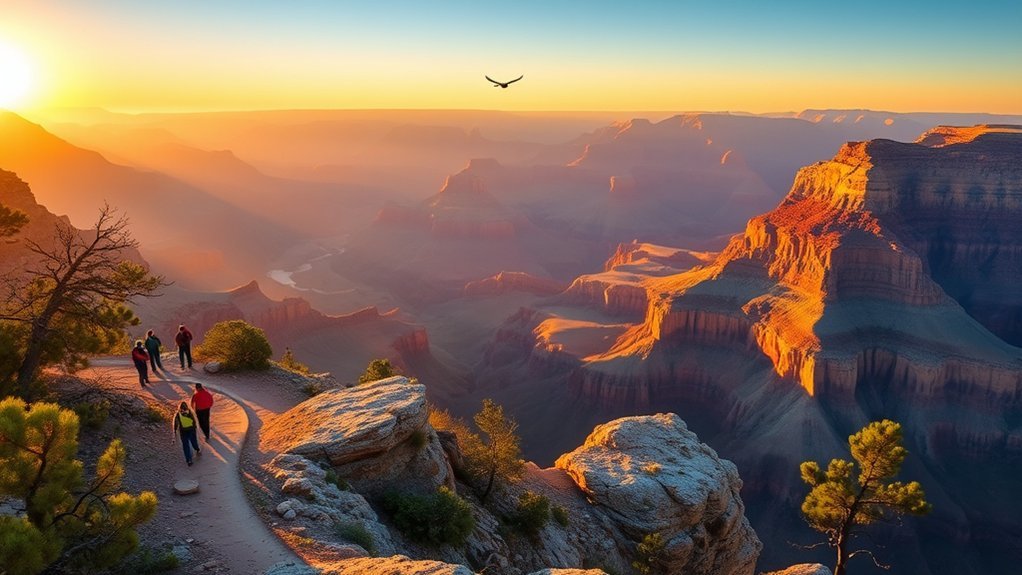
A rim-to-horizon panorama greets you the moment you arrive at the South Rim of the Grand Canyon, where layered cliffs, plunging vistas, and ever-changing light make every viewpoint feel distinct. You’ll find accessible overlooks like Mather Point and Yavapai that deliver sweeping scenes within minutes of parking, so you can maximize time without strenuous effort. If you want a brief hike, try the Rim Trail for gentle walking between viewpoints or descend a short way on the Bright Angel Trail to experience canyon textures and scale without committing to multi-day treks. Ranger talks and the Visitor Center offer concise geology and safety tips that help you understand what you’re seeing and plan responsibly. Bring water, sun protection, and sturdy shoes; weather shifts quickly and elevation affects exertion. The South Rim’s infrastructure, shuttle buses, and clearly marked paths make it an ideal, rewarding day trip from Flagstaff—one that connects you to a landscape you won’t forget.
Sedona Red Rock Country: Scenic Drives and Vortex Stops
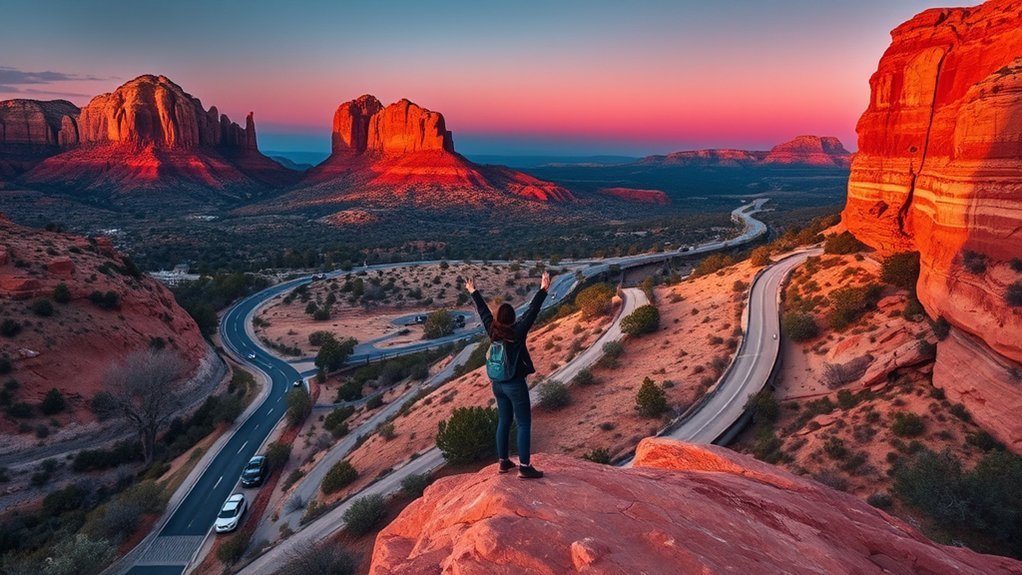
Swing through Sedona and you’ll be met by sculpted red sandstone, winding scenic byways, and an energy-seeker’s buzz at well-known vortex sites. You can drive the Red Rock Scenic Byway (SR 179) for postcard views, stop at Chapel of the Holy Cross for dramatic panoramas, and continue to Oak Creek Canyon for a cooler, shaded canyon feel. Pull over at designated overlooks to hike short trails—Bell Rock, Cathedral Rock, and Doe Mountain offer manageable climbs and rewarding viewpoints. If you want a guided spin, local jeep tours add geology and history while steering through narrow washes. For a different pace, explore Tlaquepaque Arts & Shopping Village between outings, sample local Southwest cuisine, and watch light shift across the rocks at sunset. Plan ahead for parking and reservations during peak season. Whether you crave photography, mild adventure, or the reputed vortex energy, Sedona’s compact layout makes it an ideal, easily achievable day trip from Flagstaff.
Walnut Canyon National Monument: Ancient Cliff Dwellings
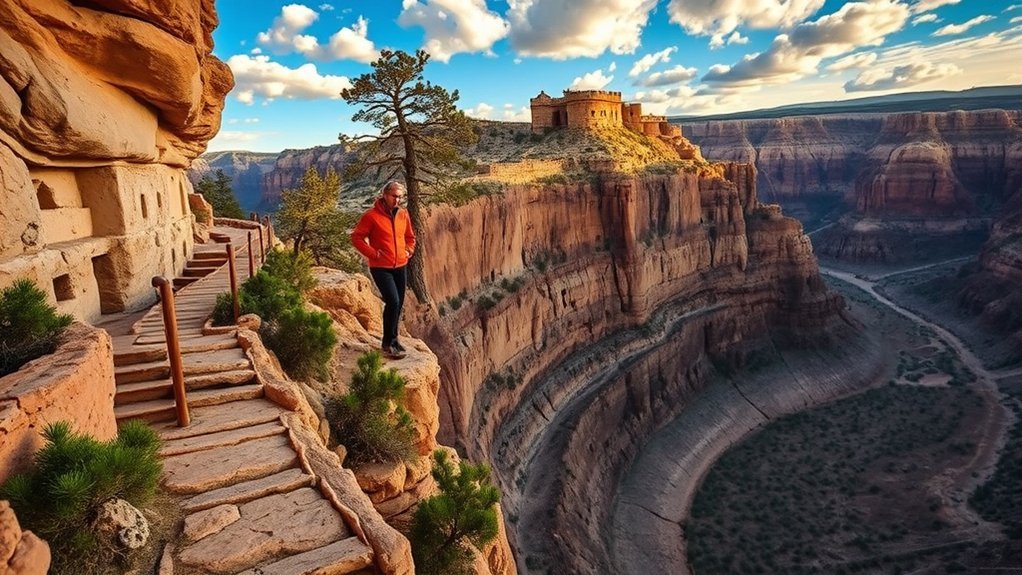
You’ll be captivated by Walnut Canyon National Monument, where ancient cliff dwellings cling to the basalt walls and tell stories of early inhabitants. Take the Rim Trail for easy access and sweeping views that frame both the ruins and the canyon’s layered geology. Keep your eyes peeled for mule deer, scrub jays, and the subtle rock formations that reveal the area’s volcanic past.
Ancient Cliff Dwellings
Stone rooms carved into the canyon face invite you to step back a thousand years at Walnut Canyon National Monument, where ancient cliff dwellings cling to ledges and tell the story of the Sinagua people. You’ll feel a direct connection as you explore compact masonry, mortar-smoothed walls, and narrow entryways that reflect resourceful living. Interpretive signs explain daily life, agriculture, and trade, helping you imagine families cooking, weaving, and watching seasons change. Look for details that bring the past alive:
- Sun-warmed stone surfaces showing hand-shaped masonry.
- Small alcoves and original ledges used for storage and shelter.
- Petroglyph fragments and tool marks hinting at craftsmanship.
Visiting these dwellings teaches you respect for preservation and rewards curiosity with vivid, tactile history.
Rim Trail Access
Perched along the canyon edge, the Rim Trail gives you an easy, scenic way to access the overlooks and interpretive displays that frame Walnut Canyon’s cliff dwellings—follow the paved path from the visitor center, where clear signage and well-placed benches guide your pace and offer sweeping vistas before you descend. You’ll find the trail accessible for most fitness levels, with short spur paths to vantage points that reveal masonry niches and terraces. Interpretive panels explain human stories and construction techniques, so you’ll appreciate the site before you reach the more rugged steps down. Stick to marked routes to protect fragile archaeology and enjoy stress-free viewing. Plan for shade, comfortable shoes, and cameras to capture the dramatic rim views.
| Feature | Benefit |
|---|---|
| Paved path | Easy walking |
| Benches | Rest spots |
| Signage | Clear info |
| Overlooks | Photogenic views |
Wildlife and Geology
After you’ve taken in the rim views and interpretive panels, look down and around to spot how wildlife and geology shaped the people who built here. You’ll see sandstone cliffs carved by time, offering shelter; pine and juniper benches that supported food and fuel; and animal tracks that hint at a shared landscape. As you descend the island trail, imagine the rhythm of daily life tied to seasons, springs, and migrating game. Notice how alcoves face sunlight for warmth and runoff channels collect scarce water—practical geology. Let these observations convince you that preservation matters: these ruins tell survival strategies written in stone and soil. Picture it:
- Cliff alcoves warmed by afternoon sun.
- Thin soil pockets with wild grains and shrubs.
- Small game trails weaving below the dwellings.
Wupatki and Sunset Crater: Volcanic Landscapes and Archaeology
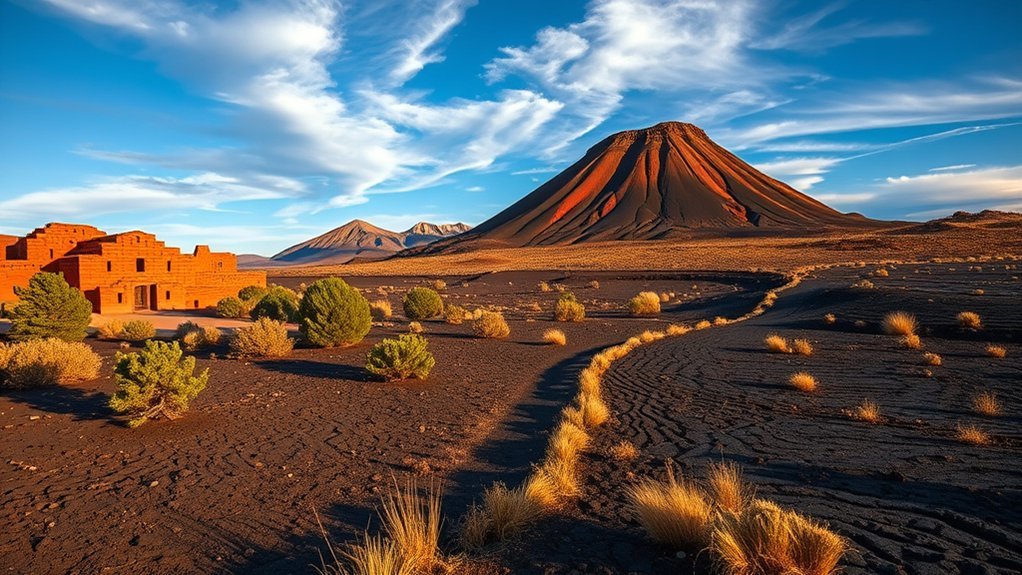
While you might come for the stark lava flows, Wupatki and Sunset Crater together offer a striking mix of volcanic drama and human history you won’t want to miss: Sunset Crater’s jagged cinder cones and blackened fields show the raw power of eruptions from roughly 1,000 years ago, and nearby Wupatki Pueblo reveals how Indigenous communities adapted to that changed landscape, building pueblos from the very volcanic rock you’re standing on. You’ll hike among hardened lava, watch contrasts of black glassy basalt against sage and sky, and trace ancient masonry where rooms, ballcourts, and communal spaces cluster around plazas. Park signage and short trails explain eruption chronology, trade networks, and agricultural ingenuity like water-harvesting in pumice soils. Bring sturdy shoes and sun protection; the terrain’s uneven and exposure is real. Guided walks deepen context, but you can also wander independently, imagining daily life amid cinder cones. This pair of sites rewards curiosity—leave with a clearer sense of geological force and resilient human adaptation.
Oak Creek Canyon and Slide Rock State Park: Swim and Picnic
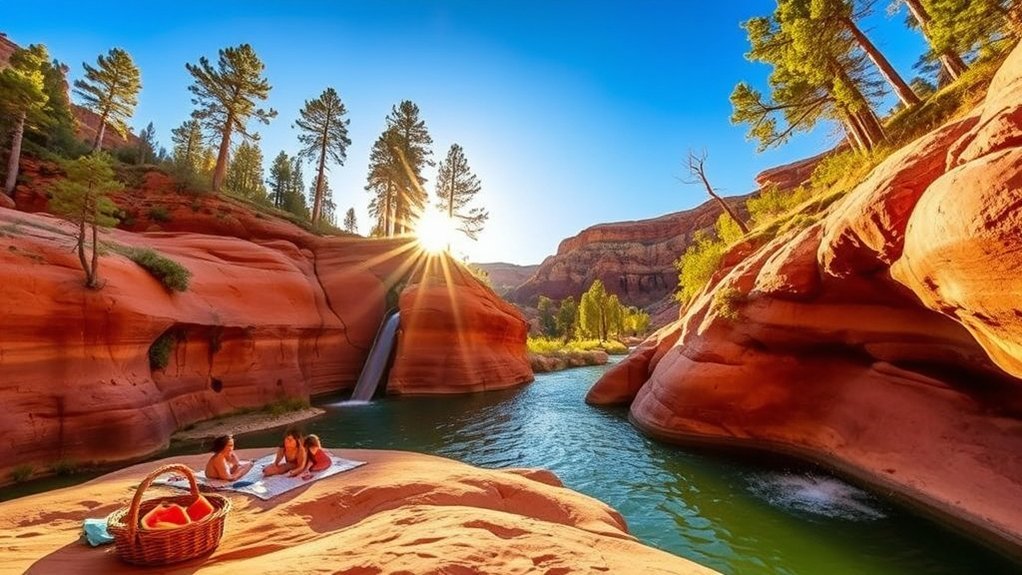
From the stark, volcanic vistas near Wupatki you can head south into a completely different kind of Arizona beauty: Oak Creek Canyon’s narrow, rippling gorge feels like a desert river cut through a gallery of red and cedar. You’ll find cool water, shaded pools and dramatic cliffs that invite a rejuvenating swim or a relaxed picnic. Slide Rock State Park is the highlight—natural sandstone slides and clear oak-lined swimming holes make it easy to unwind and play.
- Smooth red rock chutes where water polishes your route downstream.
- Deep emerald pools framed by cottonwoods and towering juniper.
- Picnic tables tucked under cedars with canyon views and bird song.
You should bring swimwear, water shoes, sun protection and a small cooler. Arrive early in summer—parking fills fast—and follow posted rules to protect the habitat. Oak Creek feels intimate and wild; it’s an effortless, satisfying day trip from Flagstaff.
Jerome Historic Mining Town: Art, History, and Panoramic Views
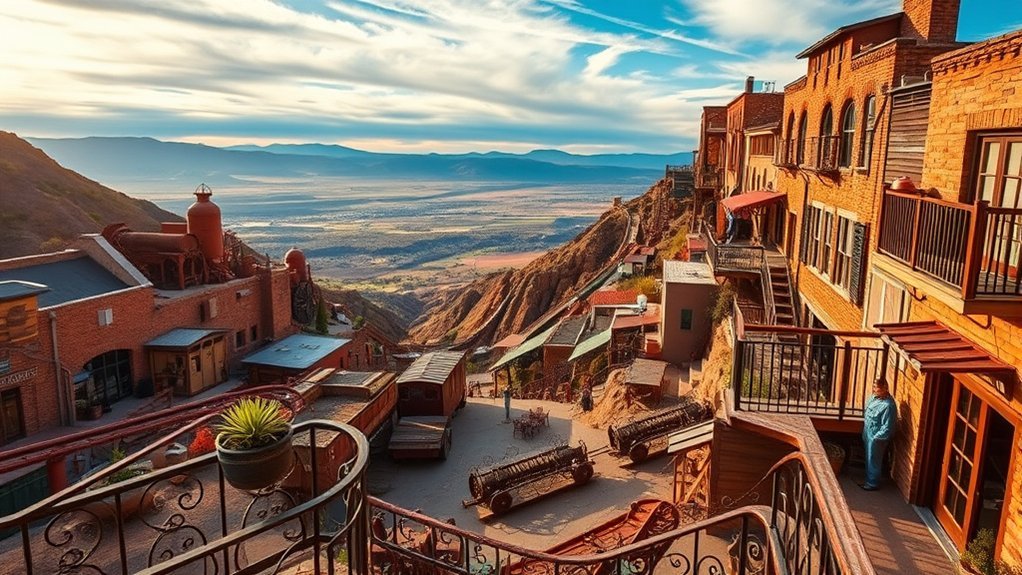
You’ll step into Jerome and feel the town’s mining-era history around every crooked building and reclaimed shaft, where interpretive signs and museums make the past vivid. You’ll explore eclectic galleries and studios packed with local art that reflects the town’s gritty charm. From multiple scenic overlooks you’ll get sweeping views of the Verde Valley and rugged mountains that reward the short climb.
Mining-Era History
Tucked into a steep mountainside, Jerome grabs your attention with its weathered brick storefronts, narrow winding streets, and a skyline stitched by old mine headframes—remnants that tell a vivid story of Arizona’s copper boom. You’ll trace that history through preserved shafts, interpretive plaques, and the Jerome State Historic Park, where a restored mine manager’s home and mining exhibits lay out the rise-and-fall cycle of extraction and community. Imagine the town at its peak:
- Rattle of ore cars and clanging tools echoing through timbered tunnels.
- Rows of stamp mills crushing rock, copper glinting like hidden treasure.
- Wooden headframes silhouetted against sunset, marking veins of industry.
You’ll leave with a sharper sense of how mining shaped landscape, livelihoods, and legacy—compelling reasons to visit.
Arts and Galleries
Explore Jerome’s arts scene and you’ll find creativity carved into every nook of this cliffside town. You’ll wander narrow streets to discover galleries packed with local painting, glasswork, and sculpture that echo the town’s mining past. You can meet artists, watch demonstrations, and take home pieces that feel rooted in place. Small museums and converted storefronts juxtapose history with contemporary craft, so your visit feels both authentic and fresh. Pop into galleries on Main Street, ask about artist talks, and time your trip for First Friday events when studios open late. Here’s a quick guide to what you’ll find:
| Gallery Type | What to Expect |
|---|---|
| Painting & Prints | Landscape, historical scenes |
| Glass & Jewelry | Handblown, silverwork |
| Sculpture | Metal, found-object |
| Mixed Media | Experimental, local themes |
Scenic Overlooks and Views
When you step onto Jerome’s cliffside walkways, sweeping views unfold that make the town’s mining past and rugged landscape feel immediate and cinematic. You’ll want to linger at overlooks where rusted equipment and stone foundations punctuate the valley below, and galleries perch above canyons framing sunsets. Jeromes’ vistas teach you history through sight; every ridge hints at ore veins and every adobe roof maps a past community.
- Sunlit ruins: oxidized beams, stairways, and shafts cutting the hillside.
- Verde Valley panorama: orchards, river ribbon, and distant mesas under vast sky.
- Twilight silhouette: town roofs and smokestacks etched against a flaming horizon.
Visit intentfully—you’ll leave with sharper perspective and memorable photos.
Historic Route 66 to Williams and Bearizona Wildlife Park
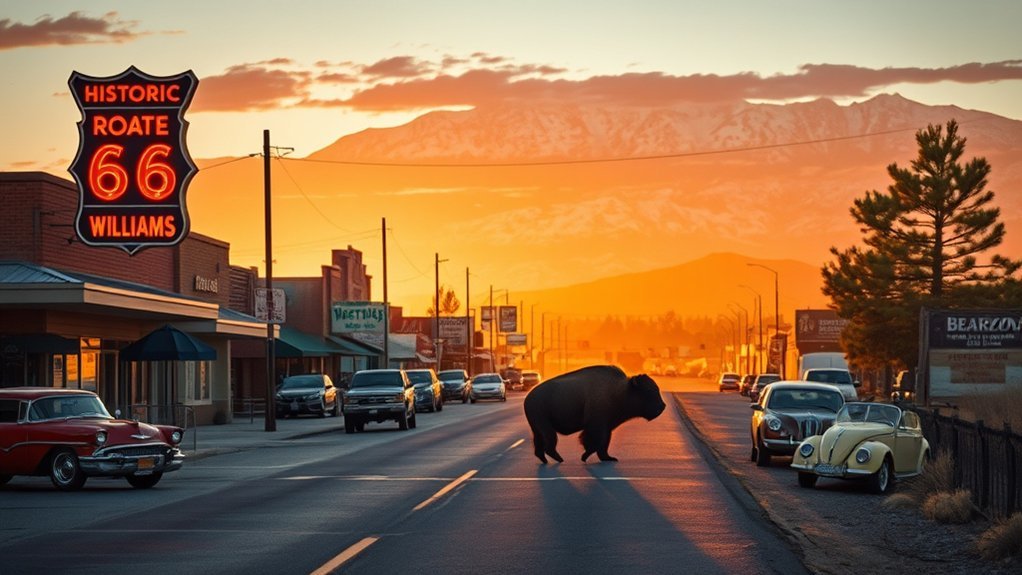
Follow Historic Route 66 west from Flagstaff and you’ll roll into Williams, a small town that feels like a living postcard of neon signs, restored motels, and 1950s diners, then continue to Bearizona Wildlife Park where you can drive through enclosures to see bison, bears, wolves, and mountain goats up close. You’ll enjoy a nostalgic walk down Route 66—shop classic memorabilia, snap photos of vintage facades, and grab a milkshake at a diner that hasn’t changed much since the 1950s. Then head to Bearizona, a well-run wildlife park that blends convenience and conservation: your car becomes a safe viewing platform as animals roam in habitats designed to resemble their native terrain. Guided talks and walk-through areas add context about behavior and habitat. Plan for a half-day each in Williams and Bearizona, bring water and binoculars, and arrive early to avoid crowds. It’s an accessible, family-friendly outing that pairs Americana charm with close-up wildlife encounters—perfect for a memorable, easy day trip.
Frequently Asked Questions
Are Pets Allowed on Trails and in Parks on These Day Trips?
Yes — many trails and parks allow pets, but rules vary: you’ll need to keep dogs leashed, clean up waste, and avoid fragile habitats. Check specific park regulations, seasonal restrictions, and any size or breed policies before visiting.
What Are the Best Months for Avoiding Crowds?
Late fall (October–November) and late winter to early spring (February–March) are best; you’ll avoid summer crowds and holiday spikes, enjoy cooler days, clearer trails, and more solitude while still accessing most viewpoints and services.
Are Restrooms and Water Available Along These Routes?
Yes — you’ll find restrooms and water at major trailheads, visitor centers, and some park facilities, but not consistently on remote stretches; bring extra water, a refill bottle, and plan stops to avoid surprises and stay hydrated.
Can I Refill a Car or Rent One in Flagstaff Easily?
Yes — you can: Flagstaff’s gas stations and multiple rental agencies make refueling or renting easy, so you won’t face wilderness exile. Expect competitive rates, varied vehicle choices, and helpful staff to get you back on the road.
Do Any Destinations Require Advanced Permits or Reservations?
Yes — some spots need permits or reservations. You’ll want advance passes for Antelope Canyon tours, shuttle reservations at Zion, and campsite permits in popular parks; book early to secure times, guided access, and peak-season spots.
Conclusion
Ready for a day full of surprises? From the Grand Canyon’s rim walks to Sedona’s red-rock vortexes, Walnut Canyon’s cliff dwellings, Wupatki and Sunset Crater’s volcanic echoes, and Slide Rock’s cool swims, each trip delivers history, adventure, and stunning views. Wander Jerome’s artsy streets, roll down Route 66 to Williams, or meet wildlife at Bearizona—pick one and go: which adventure will you choose today to make memories that last?

